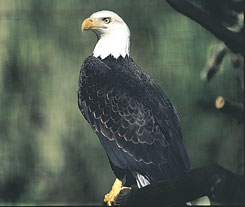Tiny Enemy Hiding In Hydrilla
One of the less obvious, but perhaps more tragic, consequences of aquatic invasive plants in South Carolina waters is the death of bald eagles.
 More than one hundred of the iconic birds have died in recent years across the Southeast, doomed after eating waterfowl like American coots that themselves were afflicted with a disease called avian vacuolar myelinopathy (AVM).
More than one hundred of the iconic birds have died in recent years across the Southeast, doomed after eating waterfowl like American coots that themselves were afflicted with a disease called avian vacuolar myelinopathy (AVM).
Researchers believe the source of the disease is a neurotoxin produced by a blue-green algae that has found an ideal host, unfortunately, on hydrilla and other invasive water plants.
Susan Wilde, a Charleston-based research scientist for the S.C. Department of Natural Resources and the University of South Carolina, has been exploring the connection for several years.(Now with the University of Georgia)
“We feel like it’s a fairly serious problem in locations where it occurs,” she says. “And our concern is it could spread as invasive plants spread. That’s why we coordinate our work with others, to track the spread of the plants and AVM together and try to learn more about that connection.”
AVM is a nasty condition. Characterized by lesions in the white matter of the central nervous system, it causes birds to appear uncoordinated or intoxicated, flopping about in the water and eventually dying as they slip into paralysis.
“Those vulnerable birds, especially coots, are prime prey for bald eagles,” Dr. Wilde says. Dozens of the big raptors have been killed by AVM in recent years in South Carolina, most around reservoirs with high hydrilla populations. But not always.
“We’re studying why hydrilla in some impoundments but not others apparently has the cyano-bacteria, another name for the blue-green algae, and then the neurotoxin that sometimes but not always follows,” Wilde says.
Researchers have some pretty solid evidence that eliminating invasive plants helps. For instance, since hydrilla was nearly eliminated from Lake Murray, AVM deaths have disappeared.
“We’re not necessarily saying that’s the solution for every location, but we certainly feel that you can break the cycle by getting rid of invasive plants where the disease is prevalent,” Wilde says.
Related Items:
- Invasion of the Aquatic Exotics
- Freshwater Animals: Invaders on Feet and Fins
- Aquatic Invasive Species: SC’s Most Wanted
- Freshwater Plants: Tenacious Tendrils
- Tiny Enemy Hiding In Hydrilla
- Marine Animals: Coming in on the Tides
- Marine Plants: Commanding the Coastline
- Get the Complete document in PDF format
Text for this supplement by Marc Rapport, free-lance writer and senior writer for the S.C. Department of Parks, Recreation & Tourism.
© 2007 South Carolina Wildlife magazine, July - August 2007

